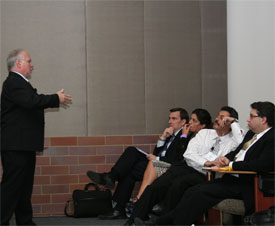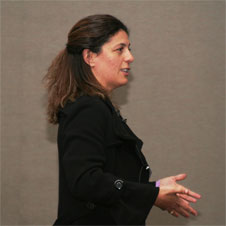Research Taps into Technology to Solve Water Woes
Irvine, Calif., Nov. 20, 2008 -- Most of the 125 people who attended H2Ology, the Igniting Technology event held this week at the UC Irvine division of Calit2, might have been aware that a serious global water crisis is afoot.
After watching the 15-minute film “Running Dry: A Call to Action” that opened the event, they knew it for certain.
What they might not have realized is the role information technology is playing in the race to solve the problem and avert an all-out disaster.
Tasks including tracking and providing ready access to previously inaccessible data, translating scientific information for policymakers, monitoring quality and educating consumers are all enabled by the unlimited potential of information technology, the audience learned.
|
|
Four UCI Calit2-affiliated professors and a venture capitalist with experience in international water markets shared their expertise.
Bill Cooper, director of UCI’s Urban Water Research Center, discussed efforts to increase sustainability. He touched on the quality of recycled water, telling the audience that it is “better quality than most other potable water.”
|
He also addressed water’s very low price tag, saying that the $2.29 he paid for a gallon of gas last week would buy 16 tons of water at current prices. “The fact is that until water becomes more expensive, consumers don’t have a good reason to conserve and innovators don’t have reason to develop and market [conservation-based] products,” he said.
David Feldman, chair of the Department of Planning, Policy and Design, addressed technology from the user’s perspective. Technological tools can only be effective if decision-makers, public officials and ordinary citizens can get the information they need in a form that is useful to them, he said.
“The technologies are very sophisticated; we can forecast drought, predict floods, protect fisheries and other resources, and avert fire hazards. But [the tools] are limited by policy issues and must embrace the translation of information into forms that are useful for decision-makers.”
He cited two ways of describing the same problem: “‘What is the maximum probable flood stage of a river during large flood events?’ That is a very analytical construct …,” he explained. “But to a decision-maker, a much more useful question would be ‘how many homes and businesses in a community are threatened if a river crests at a certain height?’”
NOAA (National Oceanic and Atmospheric Administration) and NASA developed a forecasting tool to answer the second question. Called the Advanced Hydrologic Prediction System, it was created with input from the decision-makers who will actually use it, Feldman said. “That is a model we need to aim for” when developing new technology, he added.
That is exactly what Bisher Imam, a researcher at UCI’s Center for Hydrometeorology and Remote Sensing, is trying to accomplish. “We do a lot of work with the National Weather Service and we develop a lot of the tools they need to assess and improve their [forecasting] models,” he said.
He also works with satellite precipitation. Ultimately, the goal is to integrate the tools and the data to support decision-making. “We try to integrate what we have learned from hydrologic and land/surface models with additional satellite information so that water supply forecasting can be more accurate.”
Imam explained that remote sensing is done by satellites that are like a “very, very sophisticated camera that sees what our eyes cannot see.”
Most of the world doesn’t have access to a sophisticated network of observation, Imam said. He and his team are working with UNESCO to use satellite data to estimate rainfall in other countries; they have developed a Web site that makes the information easily accessible to anyone. He demonstrated the site on the HIPerWall in the Visualization Lab after the presentation concluded.
Iman also discussed UCI’s collaboration with Northrop Grumman and NASA to test a high-resolution imaging device called the Hyperspectral Airborne Tactical Instrument. The instrument can obtain detailed views of trees, vegetation, soil, moisture and other ground data that aids in forecasting.
Crista Lopes, associate professor of informatics, is creating a wiki-type Web application that allows the sharing of water data with a wide range of users. The project, on which Lopes is collaborating with Stan Grant, professor of chemical engineering and materials science, began as a Web portal. She soon discovered, she said, “that the way most science and policy institutions develop Web sites is completely broken. Anytime they wanted to change [information on the site], we were in the way.”
So Lopes created CalSWIM (California Sustainable Watershed/Wetland Information Manager), a site based on the incorporating the knowledge of a wide population. “Wikis are very easy to use and they can be made widely available,” she said.
Unlike Wikipedia, security features are built in. CalSWIM requires users to register and has added access-control elements. The site, which is still in an experimental phase, hopes to attract different groups, including contractors and agencies, the public, and scientists.
“The idea is for this site to be kind of a hub for a lot of different data that come from different sources to be made available to the public,” she said.
The last presenter of the evening was Hank Habicht, managing partner of the Washington, D.C. office of SAIL Venture Partners L.P. According to Habicht, three billion people will face water scarcity by 2025, a fact that is leading to increasing private equity involvement and a $500 billion market.
What investors are looking for, Habicht said, are business models that deliver water treatment, conservation and reuse cost-effectively. Developing markets will include technology that can address advanced purification, rainwater harvesting, desalination and security.
A huge market is emerging in Africa and Asia. Because a significant percentage of the population is without access to safe drinking water, domestic and industrial waste is causing biological pollution and threats to supply exist, there is a need for “new partnerships and business models,” he said.
One model involves community-based “water centres.” These micro-utilities include ultraviolet disinfection modules and filter banks, as well as health and hygiene education programs. The centers will also train local staff to run them and will serve as natural social gathering spots.
“There is a triple-line bottom impact” from these endeavors, Habicht said. Communities will benefit economically, socially and environmentally – a win-win situation.
The event, which was sponsored by patent law firm Knobbe Martens, Olson & Bear, was moderated by KMOB partner Michael Guiliana. It included a panel discussion, audience question-and-answer session, refreshments and technology demonstrations.




.jpg)
